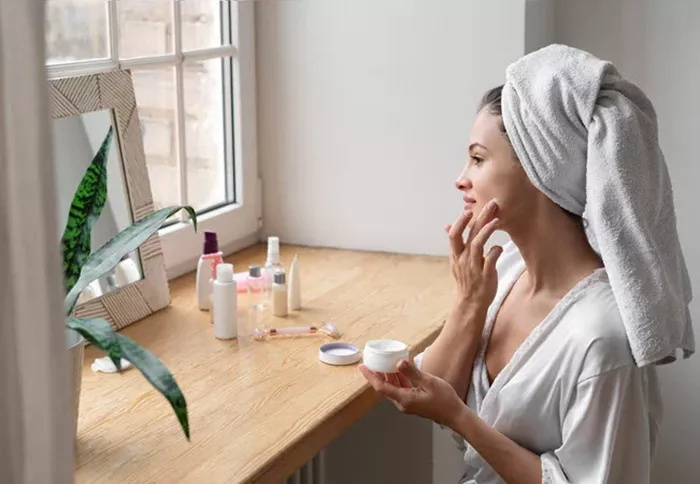Taking care of your skin is essential for maintaining a healthy and youthful appearance. A good skincare routine can help you prevent common issues like acne, dryness, and premature aging. If you are a beginner, it may seem overwhelming with so many products available. However, skincare does not have to be complicated. This guide will help you build a simple and effective routine that suits your skin type and concerns.
Understanding Your Skin Type
Before starting a skincare routine, it is important to know your skin type. Your skin type determines which products will work best for you.
Common Skin Types:
- Normal Skin: Balanced skin with no major issues. Not too oily or too dry.
- Oily Skin: Produces excess oil, leading to shine and acne.
- Dry Skin: Lacks moisture and may feel tight, rough, or flaky.
- Combination Skin: Oily in some areas (like the T-zone) and dry in others.
- Sensitive Skin: Easily irritated by skincare products, weather, or certain ingredients.
To determine your skin type, wash your face with a gentle cleanser and wait for 30 minutes without applying any products. If your skin feels tight, you likely have dry skin. If it looks shiny, you may have oily skin. If only certain areas are oily, you likely have combination skin.
Essential Steps For A Beginner’s Skincare Routine
A beginner’s skincare routine should be simple and easy to follow. You only need three essential steps to start: cleansing, moisturizing, and applying sunscreen.
1. Cleansing – Wash Your Face
Cleansing removes dirt, oil, and makeup from your skin. It is important to choose a gentle cleanser that does not strip your skin’s natural oils.
- Use a mild, fragrance-free cleanser that suits your skin type.
- Wash your face twice a day – in the morning and before bed.
- Use lukewarm water, as hot water can dry out your skin.
- Avoid using harsh soaps or scrubs, as they can irritate your skin.
2. Moisturizing – Keep Your Skin Hydrated
Moisturizing is important for keeping your skin soft and hydrated. It also helps to strengthen your skin barrier.
- Choose a lightweight, non-comedogenic moisturizer if you have oily skin.
- For dry skin, use a rich, hydrating moisturizer with ingredients like hyaluronic acid or ceramides.
- Apply moisturizer immediately after washing your face to lock in moisture.
3. Sun Protection – Apply Sunscreen Daily
Sunscreen is the most important step in any skincare routine. It protects your skin from harmful UV rays, which cause premature aging, dark spots, and skin cancer.
- Use a broad-spectrum sunscreen with at least SPF 30.
- Apply sunscreen every morning, even on cloudy days.
- Reapply every two hours if you are outside or sweating.
Additional Skincare Steps (Optional)
Once you are comfortable with the basic steps, you can add more products to target specific concerns.
4. Exfoliation – Remove Dead Skin Cells
Exfoliation helps remove dead skin cells, making your skin smoother and brighter.
- Use a gentle exfoliant once or twice a week.
- Chemical exfoliants (like glycolic acid or salicylic acid) are better than harsh scrubs.
- Do not over-exfoliate, as it can irritate your skin.
5. Serums – Treat Specific Skin Concerns
Serums contain concentrated ingredients that address specific issues such as acne, dark spots, or wrinkles.
- For hydration, use a serum with hyaluronic acid.
- For acne-prone skin, try a serum with niacinamide or salicylic acid.
- For anti-aging, look for serums with retinol or vitamin C.
6. Eye Cream – Reduce Dark Circles and Puffiness
Eye creams can help with dark circles, puffiness, and fine lines.
- Use a lightweight, hydrating eye cream.
- Apply a small amount using your ring finger to avoid tugging the delicate eye area.
Common Skincare Mistakes To Avoid
- Using Too Many Products at Once: Start with the basics and introduce new products slowly.
- Skipping Sunscreen: Sunscreen is essential, even if you stay indoors.
- Overwashing Your Face: Washing too often can strip natural oils and cause dryness.
- Picking at Pimples: This can cause scars and infections.
- Not Removing Makeup Before Bed: Sleeping with makeup can clog pores and cause breakouts.
How Long Does It Take To See Results?
Skincare is a long-term commitment, and results do not appear overnight. Here is a general timeline for improvements:
- 1-2 weeks: Skin feels more hydrated and soft.
- 4-6 weeks: Reduced acne and breakouts.
- 8-12 weeks: Brighter complexion, fewer dark spots, and smoother texture.
Be patient and consistent with your routine. If you experience irritation, adjust your products accordingly.
Conclusion
Starting a skincare routine does not have to be complicated. Begin with cleansing, moisturizing, and applying sunscreen. Once you build a habit, you can add other steps like exfoliation and serums. Always choose products based on your skin type and needs. With time and consistency, you will achieve healthier and glowing skin!
Related topic:
When To Use Squalane In Skincare Routine?
What Do I Need For A Good Skincare Routine?
Do I Really Need A Skincare Routine?


